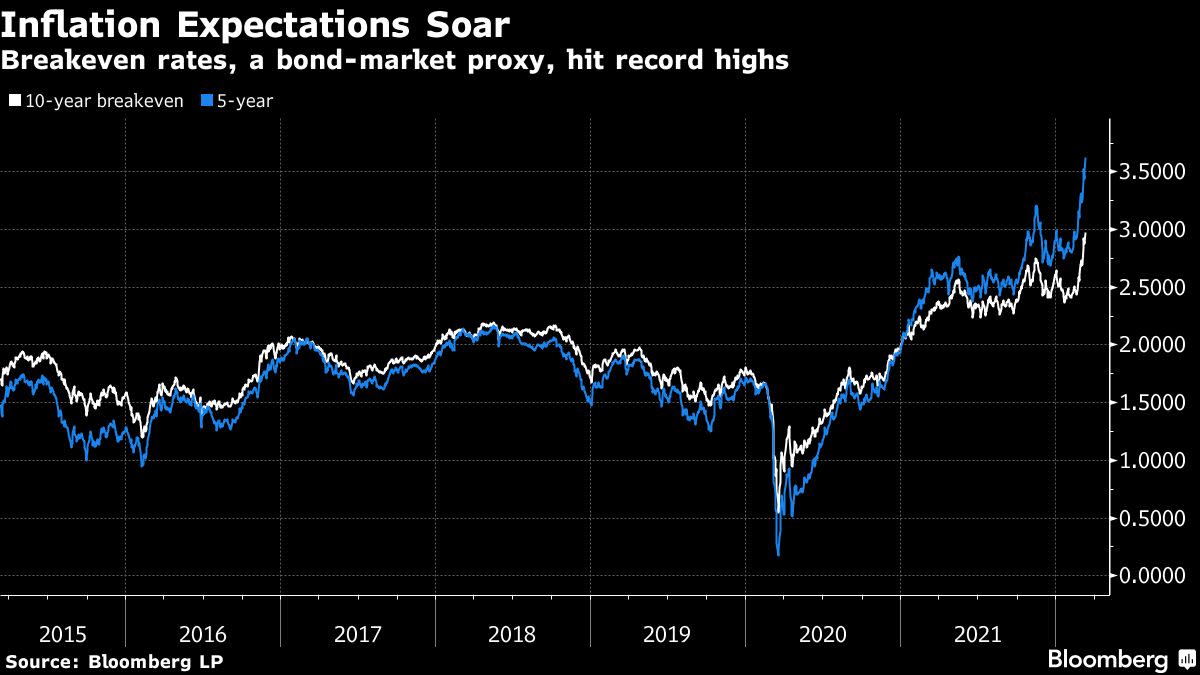
(Bloomberg) — Bond traders are virtually certain the Federal Reserve will raise interest rates by a quarter percentage point on Wednesday. What they’re watching for is where the central bank is heading after that.
Two-year Treasury yields, which are highly sensitive to monetary policy changes, have already climbed to the highest since September 2019 with the central bank poised to begin a cycle of rate hikes to slow the steepest inflation surge in four decades. The jump in food and fuel prices since Russian’s invasion of Ukraine is adding to the price pressure, increasing speculation that the Fed in the next few months could follow next week’s move with a 50-basis-point hike — something it hasn’t done since 2000.
The market may receive another jolt if Fed Chair Jerome Powell indicates during his post-meeting comments that inflation is growing more problematic. Analysts will also be watching for the latest update to Fed officials’ interest-rate projections — known as the “dot plot” — to see if they support the market’s current expectations. Swaps are now pricing in at least six quarter-point hikes in 2022, compared with the three indicated by the Fed’s last dot-plot release in December.
“We went from a complete focus on central banks to the war in Ukraine — and now with the back up in Treasury yields the market is back to watching central banks,” said Gregory Faranello, head of U.S. rates strategy at AmeriVet Securities. He said that while the Fed will “likely move gradually, the trajectory is clearly higher in terms of rates, along with a bearish flattening in the yield curve.”
Since Powell said he favors a quarter-point move next week but is open to larger changes if warranted, traders are pricing in a roughly fifty-fifty chance of a 50 basis-point move at the following meeting in early May.
Investors are also alert for any insights on the Fed’s plans to reduce its more than $8 trillion of asset holdings, another step that will pull money out of the financial system as it stops reinvesting the proceeds of maturing bonds. Powell said this month that the central bank will likely set the pace for that reduction during next week’s meeting, though the full details of the plan likely won’t be forthcoming until later.
The Fed is having to walk a fine line by tightening policy enough to cool inflation but not so much that it drives the economy into a recession. The jump in the price of oil and other commodities has added further uncertainty by threatening to both slow economic growth and add to inflation.
What Bloomberg Intelligence Says
“Clues to the future path of Federal Reserve interest-rate moves and policy makers’ reaction to slowing real economic activity will overshadow the initial 25-bp hike that’s expected on March 16. The market rarely prices for the Fed’s dots to be realized, yet shifts in dispersion will get attention. How inflation develops will be key to future hikes.”
— Ira. F. Jersey and Angelo Manolatos
Bond-market gauges of expected inflation, known as breakeven rates, have reached record levels on some maturities. That is a warning sign of a potentially more aggressive Fed path since officials have shown concern in the past that expectations of rising prices can add to actual inflation.
Read more: Bond Traders’ U.S. Inflation Outlook Hits Record as Oil Rallies
The backdrop has some warning that the Fed might have to lift its policy-rate to a peak beyond the sub-2% area derivative markets are now penciling in. That’s has investors also keenly watching for any officials marking up forecasts for the long-run overnight lending rate, which had a median in December of 2.5%.
“We expect a tightening at each of this year’s seven meetings and they may do a 50-basis-point-hike at some point,” said Rob Waldner, chief fixed-income strategist at Invesco. Once the balance sheet starts shrinking, he said the bond market may also receive “a hawkish surprise” from the Fed using asset sales to help prevent an inversion of the yield curve.
The U.S. 10-year yield rose 26 basis points this week to about 2%. The 30-year bond yield reached its highest level since May before finishing the week at 2.35%.
Steven Blitz, Chief U.S. Economist at TS Lombard, said a resolution of the Ukraine war that helps drive down commodity prices may spur a more aggressive path from the Fed, since that would be a drag on economic growth.
“Powell will be very nimble about their policy path and he will take the rate tightening being offered by the bond market,” said Blitz. “The market is very comfortable about three hikes of 25 basis points by June and then the Fed announcing quantitative tightening.”
What to watch
©2022 Bloomberg L.P.